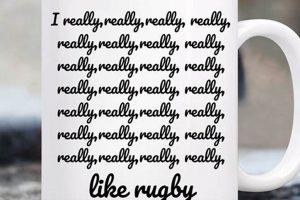Rugby league and rugby union are two popular team sports that share a common history but have evolved into distinct codes with their own unique rules and gameplay. Both sports are played with an oval ball on a rectangular field, but there are several key differences between them.
Editor’s Note:Rugby league and rugby union are both great sports with their own unique appeal. Understanding the differences between the two codes can help you decide which one is right for you.
We’ve done the research and put together this guide to help you understand the key differences between rugby league and rugby union.
Key differences
| Rugby league | Rugby union |
|---|---|
| 13 players per team | 15 players per team |
| Tackles are made by wrapping the arms around the ball carrier | Tackles are made by bringing the ball carrier to the ground using the shoulder |
| The ball can be kicked forward or backward | The ball can only be kicked forward |
| Tries are worth 4 points | Tries are worth 5 points |
Main article topics
- The history of rugby league and rugby union
- The rules of rugby league and rugby union
- The gameplay of rugby league and rugby union
- The culture of rugby league and rugby union
1. Number of players
The number of players on the field is one of the most obvious differences between rugby league and rugby union. Rugby league is played with 13 players per team, while rugby union is played with 15 players per team. This difference has a significant impact on the way the game is played.
- Fewer players on the field in rugby league means that there is more space for each player to run and tackle. This makes the game faster and more open, with more opportunities for individual brilliance.
- The smaller number of players on the field in rugby league also means that there is less congestion in the ruck and maul. This makes it easier for the attacking team to keep possession of the ball and to create scoring opportunities.
- The different number of players on the field in rugby league and rugby union also affects the way that the game is defended. In rugby league, the defending team is more likely to use a one-on-one tackling system, while in rugby union, the defending team is more likely to use a zonal defense.
The different number of players on the field is just one of the many factors that contribute to the different styles of play between rugby league and rugby union. However, it is a key factor that has a significant impact on the way the game is played.
2. Tackling
Tackling is an essential part of rugby league and rugby union, and the different tackling techniques used in each code are a major factor in the different styles of play. In rugby league, tackles are made by wrapping the arms around the ball carrier, while in rugby union, tackles are made by bringing the ball carrier to the ground using the shoulder.
- Purpose of tackling: In both rugby league and rugby union, tackling is used to stop the opposition from advancing the ball. However, the different tackling techniques used in each code reflect the different objectives of the two games. In rugby league, the primary objective is to slow down the opposition and force them to turnover possession. In rugby union, the primary objective is to bring the ball carrier to the ground and force them to release the ball.
- Technique: The different tackling techniques used in rugby league and rugby union are a result of the different rules governing each code. In rugby league, tacklers are allowed to wrap their arms around the ball carrier and bring them to the ground. In rugby union, tacklers are only allowed to use their shoulders to bring the ball carrier to the ground.
- Impact on the game: The different tackling techniques used in rugby league and rugby union have a significant impact on the way the game is played. In rugby league, the more lenient tackling rules allow for a faster and more open game, with more opportunities for individual brilliance. In rugby union, the more restrictive tackling rules make for a more structured and tactical game, with a greater emphasis on teamwork.
The different tackling techniques used in rugby league and rugby union are just one of the many factors that contribute to the different styles of play between the two codes. However, it is a key factor that has a significant impact on the way the game is played.
3. Kicking
The ability to kick the ball forward or backward is a key difference between rugby league and rugby union, and it has a significant impact on the way the game is played. In rugby league, the ball can be kicked forward or backward at any time, which allows teams to use kicking as a way to gain territory, create scoring opportunities, and relieve pressure. In rugby union, the ball can only be kicked forward, which means that teams must be more careful about when and how they kick the ball.
The different kicking rules in rugby league and rugby union have a number of implications for the way the game is played. In rugby league, teams are more likely to use kicking as a way to gain territory, as they can kick the ball forward at any time. This can lead to a more open and expansive game, with teams looking to score tries from long range. In rugby union, teams are more likely to use kicking as a way to relieve pressure and to create scoring opportunities from close range. This can lead to a more structured and tactical game, with teams looking to build pressure through forward play and then use kicking to score points.
The different kicking rules in rugby league and rugby union also have an impact on the way that teams defend. In rugby league, teams must be prepared to defend against kicks from all over the field. This can lead to a more chaotic and unpredictable game, as teams are constantly having to adjust their defensive positions. In rugby union, teams can focus their defence on defending against kicks from close range, as they know that the opposition cannot kick the ball forward from long range. This can lead to a more structured and organised defence, as teams can set up their defensive line in advance.
Overall, the different kicking rules in rugby league and rugby union have a significant impact on the way the game is played. In rugby league, the ability to kick
the ball forward or backward gives teams more options in attack and defence, which can lead to a more open and expansive game. In rugby union, the restriction on kicking the ball forward only means that teams must be more careful about when and how they kick the ball, which can lead to a more structured and tactical game.
| Rugby league | Rugby union |
|---|---|
| The ball can be kicked forward or backward at any time. | The ball can only be kicked forward. |
| Teams are more likely to use kicking as a way to gain territory. | Teams are more likely to use kicking as a way to relieve pressure and to create scoring opportunities from close range. |
| Teams must be prepared to defend against kicks from all over the field. | Teams can focus their defence on defending against kicks from close range. |
4. Scoring
The scoring system is one of the most important differences between rugby league and rugby union. In rugby league, tries are worth 4 points, while in rugby union, tries are worth 5 points. This difference has a number of implications for the way the game is played.
- Tries are more valuable in rugby union. This means that teams are more likely to focus on scoring tries in rugby union than they are in rugby league. This can lead to a more attacking and open game.
- Goals are less valuable in rugby league. This means that teams are less likely to kick goals in rugby league than they are in rugby union. This can lead to a more physical and confrontational game.
- The scoring system in rugby league encourages teams to take more risks. This is because teams are more likely to go for tries in rugby league, even if they are in a good position to kick a goal. This can lead to a more exciting and unpredictable game.
Overall, the different scoring systems in rugby league and rugby union have a significant impact on the way the game is played. The higher value of tries in rugby union encourages teams to focus on attacking play, while the lower value of goals in rugby league encourages teams to take more risks.
5. Field size
The field size is an important factor in the way that rugby league and rugby union are played. Rugby league is played on a smaller field than rugby union, which has a number of implications for the game.
One of the most significant implications of the smaller field size in rugby league is that it makes the game faster and more open. With less space to work with, players are forced to make quicker decisions and to be more creative in their attacking play. This leads to a more exciting and unpredictable game for spectators.
Another implication of the smaller field size in rugby league is that it makes it more difficult for teams to defend their line. This is because there is less space for defenders to spread out and cover the width of the field. As a result, teams in rugby league are more likely to concede tries than they are in rugby union.
The smaller field size in rugby league also has an impact on the way that teams kick the ball. In rugby league, teams are more likely to kick the ball long and high, as this gives them more time to get back into position and defend their line. In rugby union, teams are more likely to kick the ball short and low, as this gives them more control over the ball and allows them to build pressure on the opposition.
Overall, the smaller field size in rugby league has a significant impact on the way the game is played. It makes the game faster, more open, and more difficult to defend. This leads to a more exciting and unpredictable game for spectators.
| Rugby league | Rugby union |
|---|---|
| Played on a smaller field | Played on a larger field |
| Faster and more open game | Slower and more structured game |
| More difficult to defend | Easier to defend |
| Teams more likely to kick the ball long and high | Teams more likely to kick the ball short and low |
6. Game duration
The difference in game duration between rugby league and rugby union is a significant factor that contributes to the different styles of play between the two codes. Rugby league matches are shorter than rugby union matches, with a total playing time of 80 minutes compared to 80 minutes for rugby union. This difference in game duration has a number of implications for the way the game is played.
One of the most significant implications of the shorter game duration in rugby league is that it makes the game faster and more intense. With less time to work with, teams in rugby league are forced to play at a higher tempo and to make quicker decisions. This leads to a more exciting and unpredictable game for spectators.
Another implication of the shorter game duration in rugby league is that it makes it more difficult for teams to defend their line. This is because teams in rugby league have less time to set up their defence and to get into position. As a result, teams in rugby league are more likely to concede tries than they are in rugby union.
The shorter game duration in rugby league also has an impact on the way that teams manage their players. In rugby league, teams are more likely to rotate their players throughout the game in order to keep them fresh. This is because the shorter game duration means that players are less likely to be able to play for the entire 80 minutes without getting tired.
Overall, the shorter game duration in rugby league has a significant impact on the way the game is played. It makes the game faster, more intense, and more difficult to defend. This leads to a more exciting and unpredictable game for spectators.
| Rugby league | Rugby union |
|---|---|
| 80 minutes | 80 minutes |
| Faster and more intense | Slower and more structured |
| More difficult to defend | Easier to defend |
| Teams more likely to rotate players | Teams less likely to rotate players |
7. Popularity
The popularity of rugby league and rugby union varies significantly around the world. Rugby league is more popular in Australia, New Zealand, and Papua New Guinea, while rugby union is more popular in the rest of the world. This difference in popularity is due to a number of factors, including historical, cultural, and geographical factors.
One of the most important factors that has contributed to the popularity of rugby league in Australia, New Zealand, and Papua New Guinea is the fact that these countries were all former British colonies. Rugby league was introduced to these countries by British settlers in the late 19th century, and it quickly became popular among the local population. Rugby union, on the other hand, was introduced to these
countries by British settlers in the mid-19th century, but it never gained the same level of popularity as rugby league.
Another factor that has contributed to the popularity of rugby league in Australia, New Zealand, and Papua New Guinea is the fact that these countries have a strong sporting culture. Rugby league is a fast-paced and exciting game, and it appeals to the sporting sensibilities of these countries. Rugby union, on the other hand, is a more slow-paced and tactical game, and it does not appeal to the sporting sensibilities of these countries as much as rugby league does.The popularity of rugby league and rugby union also varies significantly within each of these countries. In Australia, for example, rugby league is more popular in the eastern states of New South Wales and Queensland, while rugby union is more popular in the western states of Victoria and Western Australia. This difference in popularity is due to a number of factors, including historical, cultural, and geographical factors.The popularity of rugby league and rugby union is a complex issue that is influenced by a number of factors. However, it is clear that the popularity of these two sports is closely linked to their history, culture, and geography.
Table: Popularity of rugby league and rugby union around the world
| Country | Most popular rugby code |
|---|---|
| Australia | Rugby league |
| New Zealand | Rugby league |
| Papua New Guinea | Rugby league |
| England | Rugby union |
| France | Rugby union |
| Ireland | Rugby union |
| Scotland | Rugby union |
| Wales | Rugby union |
| South Africa | Rugby union |
| New Zealand | Rugby union |
FAQs
This section addresses commonly asked questions regarding the differences between rugby league and rugby union.
Question 1: What are the key differences between rugby league and rugby union?
Rugby league and rugby union share a common history but have evolved into distinct sports with unique rules and gameplay. Key differences include the number of players on the field, the tackling technique, the use of kicking, the scoring system, the field size, and the game duration.
Question 2: Which sport is more popular globally?
Rugby union is more popular worldwide, with a larger following in countries such as England, France, Ireland, Scotland, Wales, South Africa, and New Zealand.
Question 3: Which sport is faster and more open?
Rugby league is generally considered faster and more open due to the smaller field size and the ability to kick the ball in any direction.
Question 4: Which sport is more physically demanding?
Both rugby league and rugby union are physically demanding sports, but rugby league is often considered more brutal due to the more aggressive tackling style and the higher number of tackles made per game.
Question 5: Which sport is more tactical?
Rugby union is generally considered more tactical, as it requires more complex strategies and formations, particularly in set-piece situations such as scrums and lineouts.
Question 6: Can players switch between rugby league and rugby union?
While it is possible for players to switch between rugby league and rugby union, it is not common, as the two sports require different skills and techniques.
In summary, rugby league and rugby union are both exciting and physically demanding sports with unique characteristics and global appeal.
Explore the next section: Key Differences in Gameplay
Tips for Understanding Rugby League v Union
To enhance your understanding and appreciation of rugby league and rugby union, consider the following tips:
Tip 1: Familiarize yourself with the basic rules and gameplay.
Understanding the fundamental rules and objectives of each sport will provide a solid foundation for comprehending the finer points of gameplay.
Tip 2: Observe matches and analyze strategies.
Watching live or televised matches allows you to witness the intricacies of each sport. Pay attention to the tactics employed by teams and players, and try to understand the reasons behind their decisions.
Tip 3: Explore the history and culture of the sports.
Rugby league and rugby union have rich histories and cultural significance. Learning about their origins and development can enhance your appreciation for the nuances of each sport.
Tip 4: Engage with fans and experts.
Interacting with passionate fans and knowledgeable experts can provide valuable insights and perspectives on the technicalities and strategies of rugby league and rugby union.
Tip 5: Consider attending a live match.
Experiencing the atmosphere and intensity of a live rugby match is an excellent way to grasp the true nature and excitement of these sports.
Tip 6: Practice basic skills if possible.
If you have the opportunity, practicing basic skills such as passing, tackling, and kicking can enhance your understanding of the techniques involved in rugby league and rugby union.
Summary:
By implementing these tips, you can deepen your knowledge and appreciation of rugby league and rugby union. Remember to approach the learning process with curiosity and a willingness to engage with the unique aspects of each sport.
Conclusion:
Understanding the differences and nuances between rugby league and rugby union will allow you to fully appreciate the excitement and complexities of these two captivating sports.
Conclusion
In conclusion, rugby league and rugby union, while sharing a common ancestry, have evolved into distinct sports with unique rules, gameplay, and global appeal. Understanding the differences between these two codes allows us to appreciate their individual strengths and the excitement they bring to the world of sports.
As we continue to follow the development of rugby league and rugby union, it is evident that both codes have a bright future. With their passionate fan bases, skilled athletes, and ongoing innovations, these sports will undoubtedly captivate audiences for generations to come.







